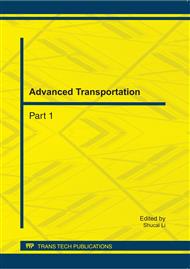p.230
p.235
p.241
p.247
p.251
p.257
p.266
p.271
p.275
Experimental Study on Asphalt Pavement Damage by Application of Acetate-Base Deicer
Abstract:
Large amounts of deicing agents (abbr. Deicer) were applied on road pavements for snow and ice control each year in the cold region. The traditional deicers used on pavements resulted in metallic corrosion of vehicle and serious adverse environmental impacts. By contrast, acetates and formates were more environmentally friendly and more effective. After application of new deicers, heavy binder bleeding and severe stripping problems were observed occurring together with loss of asphalt pavement stability in northen Europe and northen America. Recently the large quantities of acetate-based deicers applied each year in China, damage by the deicers similar to that observed in those wereas would also occur in China. To shed light on neglected distress by deicer and guide the best practices of deicer application, asphalt mix design and maintenance of asphalt pavement, the paper revealed the asphalt mixture performance variation corroded by deicers and corrosion mechanism using immersion tension test, aqueous solutiion test and immersion penetration test.
Info:
Periodical:
Pages:
251-256
Citation:
Online since:
September 2011
Authors:
Price:
Сopyright:
© 2011 Trans Tech Publications Ltd. All Rights Reserved
Share:
Citation:


